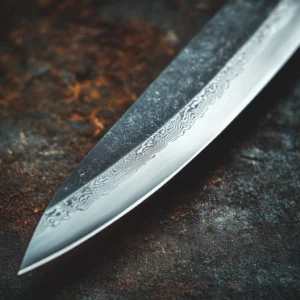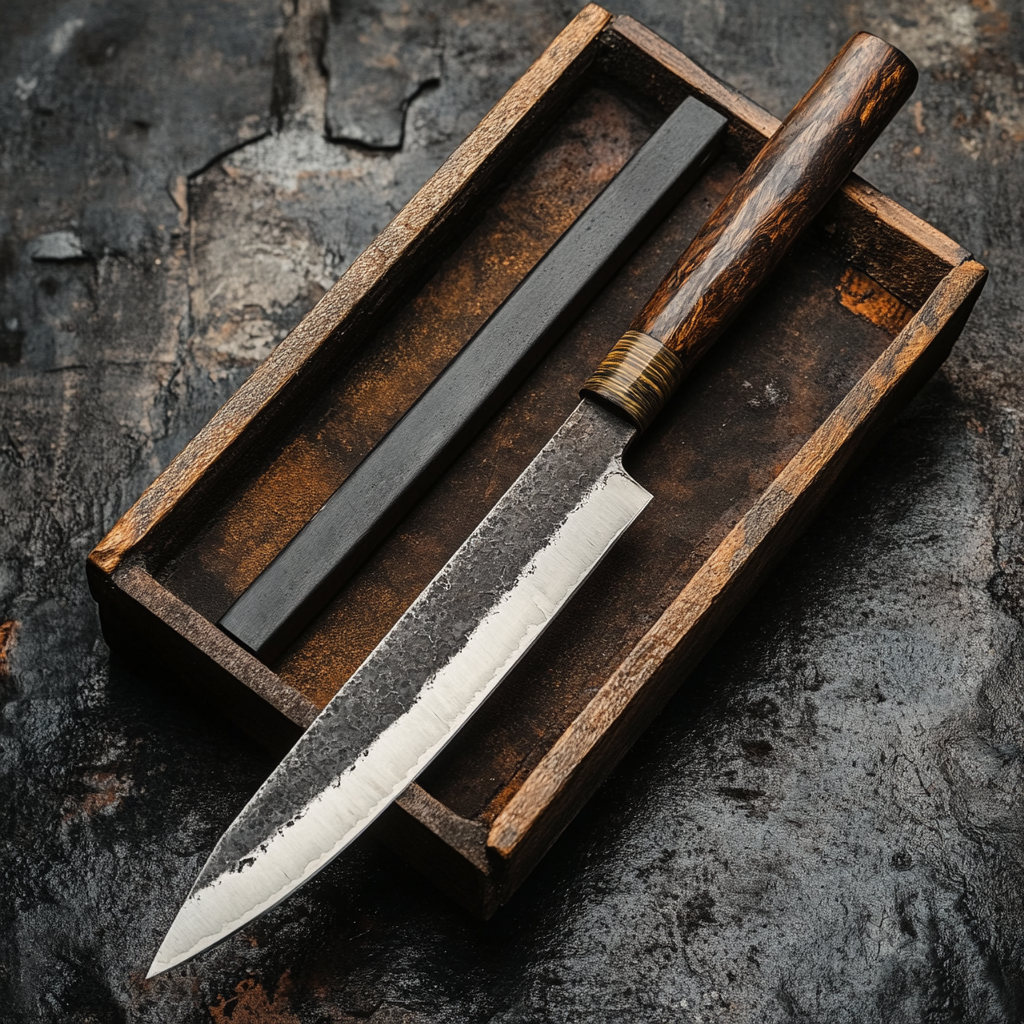How to sharpen a knife : Sharpening a knife is an essential skill for anyone who uses knives frequently, whether in the kitchen, the workshop, or outdoors. A sharp knife is safer and more efficient, making your tasks easier and more accurate. In this comprehensive guide, we will cover everything you need to know about how to sharpen a knife, from the basics of knife anatomy to advanced sharpening techniques and tips. You’ll also find some helpful external resources for further reading on how to sharpen a knife like a pro.
Why Sharpening a Knife is Crucial for Safety and Efficiency
Regular knife maintenance is essential for ensuring that your knives stay sharp and functional. A sharp knife is safer and more efficient, allowing you to perform precise cuts and work with ease. To keep your knives in excellent condition, make sure you follow a proper sharpening routine. If you need further advice on sharpening and maintaining knives, check out these expert resources:
- Wicked Edge Knife Sharpening Tools & Resources – Explore a range of sharpening tools and resources from a leading brand in knife care.
The Importance of Sharpening a Knife for Safety
Sharp knives are an essential tool in the kitchen, workshop, or any setting where cutting is necessary. Sharpening a knife allows it to cut through materials with precision and ease, preventing dangerous slips and increasing control over the blade. Whether you’re slicing tomatoes, cutting through cardboard, or using a knife in outdoor tasks, keeping the blade sharp will help you achieve clean, accurate cuts with minimal effort.
In fact, studies have shown that the force needed to cut through materials increases significantly as the sharpness of the knife decreases. A dull knife forces you to apply excessive pressure, which can lead to the knife slipping, causing injury. For more on why sharp knives are essential for safety, refer to The Spruce Eats Knife Sharpening Basics.
How Sharpening a Knife Improves Efficiency
A sharp knife improves efficiency by reducing the amount of time and effort required to complete a task. A sharp blade allows you to slice through food or materials cleanly and swiftly, saving you time during meal prep or work projects. Additionally, sharp knives are easier to control and can cut more precisely, whether you’re preparing delicate dishes in the kitchen or handling precise cuts in DIY projects.
A dull knife, on the other hand, causes more drag and requires you to work harder to get the desired results. Not only does this lead to frustration, but it also wastes valuable time.
Understanding Knife Anatomy: Key Parts and Their Role in Sharpening

Before diving into the specifics of how to sharpen a knife, it’s important to understand the basic anatomy of a knife. Knowing the parts of a knife and how they function will help you sharpen it more effectively.
- Blade: The flat part of the knife that extends from the handle. It can be made from various materials, including stainless steel, carbon steel, and ceramic.
- Edge: The sharp part of the blade used for cutting. This is the part of the knife you’ll be sharpening.
- Spine: The unsharpened, thicker portion at the top of the blade. It provides stability and strength to the knife.
- Heel: The rear part of the blade near the handle. The heel is typically used for cutting tasks that require more force, like chopping vegetables or slicing through tough materials.
- Tip: The pointed end of the blade, used for precision tasks like slicing, dicing, or scoring.
Knowing how these parts work together will help you understand where the focus should be when sharpening a knife.
How Blade Material Affects Sharpening
Different types of knife blades require different approaches to sharpening. Blade material impacts how the knife responds to sharpening tools, how often it needs sharpening, and how durable the blade will be after the process. Here are some common materials and how they affect sharpening:
- Carbon Steel: Carbon steel knives are easy to sharpen and hold an edge well, but they are more susceptible to rust and require proper maintenance.
- Stainless Steel: Stainless steel knives are more resistant to rust and corrosion but are generally harder to sharpen than carbon steel knives.
- Ceramic: Ceramic knives hold their sharpness longer but are brittle and require specialized sharpening tools like a diamond-coated sharpening stone or a ceramic rod.
For a deeper dive into understanding blade materials and sharpening, you can visit Serious Eats’ Knife Maintenance Guide.
Signs Your Knife Needs Sharpening
Knowing when to sharpen a knife is crucial for maintaining a functional and safe blade. Here are some common signs that indicate your knife is ready for sharpening:
Difficulty Cutting
One of the first signs of a dull knife is that it struggles to cut through food or other materials. If you find yourself exerting excessive pressure when cutting through soft vegetables, fruits, or even paper, it’s a clear indication that the knife needs sharpening.
Tearing or Crushing Instead of Slicing
A dull knife may crush or tear rather than cleanly slicing through food, especially when cutting delicate items like tomatoes, bread, or meats. This is because the edge is no longer sharp enough to make smooth cuts.
Visible Nicks or Chips in the Blade
If you see nicks, chips, or irregularities in the edge of your knife, it’s time to sharpen. These imperfections disrupt the cutting performance and can make the knife more difficult to use.
The Paper Test
A simple test to check the sharpness of your knife is the paper test. Try slicing through a piece of paper. If the knife cuts smoothly without tearing, it’s still sharp. If it struggles or tears the paper, the blade is likely dull and needs to be sharpened.
Tools for Sharpening a Knife

To effectively sharpen a knife, you need the right tools. There are various sharpening tools available, each with its pros and cons. Here are the most common options:
- Whetstones: Whetstones, or sharpening stones, are among the best tools for sharpening a knife. They come in various grits (coarse, medium, and fine) and allow for precise control over the sharpening process.
- Honing Rods: A honing rod is a tool used to realign the blade’s edge between sharpening sessions. It doesn’t actually remove metal but instead straightens the edge that might have become slightly misaligned during use.
- Electric Sharpeners: These are convenient and easy to use, especially for beginners. They automatically guide the knife through the sharpening process, but they may not offer the same level of control as manual sharpening.
- Manual Sharpening Systems: These systems typically come with built-in guides to help maintain the correct angle when sharpening your knife. They provide more control than electric sharpeners while being user-friendly.
- Pull-Through Sharpeners: These sharpeners are extremely easy to use, simply pull the knife through the slots to sharpen the edge. However, they may remove more material from the knife than necessary, which could lead to faster wear.
If you’re unsure which tool is best for you, refer to Blade HQ’s Knife Care and Sharpening for more information on tools for sharpening a knife.
How to Sharpen a Knife with a Whetstone

Whetstones are a versatile and effective tool for sharpening a knife. Here’s a step-by-step guide to using a whetstone:
Step 1: Soak the Stone
Start by soaking your whetstone in water for about 10-15 minutes. This step ensures that the stone remains lubricated during the sharpening process and helps prevent the blade from overheating.
Step 2: Choose the Right Grit
Use a coarse grit (200-400) if your knife is very dull or damaged. For knives that are only slightly dull, start with a medium grit (800-1000). If you’re looking to polish the blade and refine the edge, use a fine grit (3000-8000).
Step 3: Maintain the Right Angle
To achieve the perfect edge, maintain a consistent sharpening angle of 15-20 degrees. It’s essential to keep the angle steady throughout the process to ensure an even and sharp edge when you sharpen a knife.
Step 4: Alternate Sides
Sharpen each side of the blade by alternating strokes on each side of the stone. This will ensure that the edge is symmetrical and sharpened evenly.
Step 5: Hone the Blade
Once you’ve finished sharpening the knife with the whetstone, use a honing rod to smooth out any burrs or imperfections left on the blade. This will align the edge and restore the knife to its optimal cutting condition.
How to Sharpen a Knife with a Honing Rod
Honing is not the same as sharpening, as it doesn’t remove metal from the blade. Instead, honing realigns the edge of the knife to ensure it stays sharp longer.
Step 1: Position the Rod
Hold the honing rod vertically with the tip resting on a stable surface.
Step 2: Angle the Knife
Hold your knife at a 15-20 degree angle to the rod. This is the optimal angle for most knives.
Step 3: Glide the Blade
Glide the blade down the honing rod in a smooth, sweeping motion. Repeat this process on both sides of the knife until you have honed the edge. This will help keep your knife sharp for longer between sharpening.
Sharpening Serrated Knives
Serrated knives require special attention due to their unique edge. You cannot sharpen a serrated knife with a traditional whetstone, as the serrations would be damaged. Instead, use a tapered diamond rod or a ceramic rod to carefully sharpen each individual serration.
For tips on maintaining serrated knives, check out this Blade HQ article on serrated knife care.
Knife Maintenance Beyond Sharpening
To extend the life of your knives, you must also focus on proper maintenance practices:
- Store Properly: Store your knives in a way that protects the blade, such as in a magnetic knife strip, knife block, or sheaths.
- Regular Honing: Regular honing keeps the blade aligned and sharp between sharpenings.
- Clean and Dry: Always hand-wash knives and dry them immediately to prevent rusting and corrosion.
For further tips on knife care and sharpening, check out the Serious Eats Knife Maintenance Guide. At least, with a well sharpened knife, you can cut perfectly slice your cheese and meat.
Conclusion
Learning how to sharpen a knife is a valuable skill that ensures safety, efficiency, and precision in every cutting task. By using the right tools and techniques, you can maintain sharp blades for all your needs. Regular sharpening, honing, and proper storage will help your knives stay in top condition for years.


17 thoughts on “How to Sharpen a Knife: 5 Essential Methods for a Perfectly Sharp Blade”